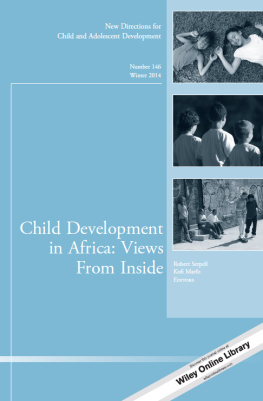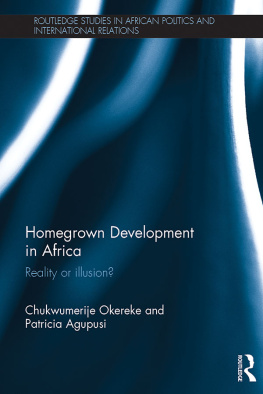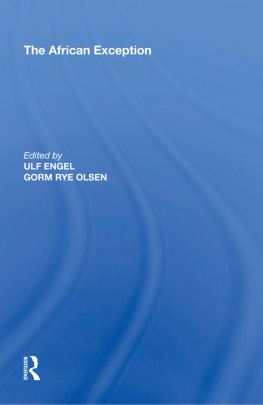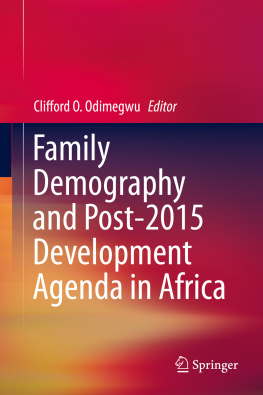
CHILD DEVELOPMENT IN AFRICA: VIEWS FROM INSIDE
Robert Serpell, Kofi Marfo (eds.)
New Directions for Child and Adolescent Development, no. 146
Lene Arnett Jensen, Reed W. Larson, EditorsinChief
2014 Wiley Periodicals, Inc., A Wiley Company. All rights reserved.
No part of this publication may be reproduced, stored in a retrieval system, or transmitted in any form or by any means, electronic, mechanical, photocopying, recording, scanning, or otherwise, except as permitted under Sections 107 or 108 of the 1976 United States Copyright Act, without either the prior written permission of the Publisher or authorization through payment of the appropriate percopy fee to the Copyright Clearance Center, 222 Rosewood Drive, Danvers, MA 01923; (978) 7508400, fax (978) 6468600. Requests to the Publisher for permission should be addressed to the Permissions Department, John Wiley & Sons, Inc., 111 River St., Hoboken, NJ 07030, (201) 7486011, fax (201) 7486008, www.wiley.com/go/permissions.
Microfilm copies of issues and articles are available in 16 mm and 35 mm, as well as microfiche in 105 mm, through University Microfilms, Inc., 300 North Zeeb Road, Ann Arbor, Michigan 481061346.
ISSN 15203247electronic ISSN 15348687
NEW DIRECTIONS FOR CHILD AND ADOLESCENT DEVELOPMENT is part of The Jossey-Bass Education Series and is published quarterly by Wiley Subscription Services, Inc., a Wiley company, at Jossey-Bass, One Montgomery Street, Suite 1200, San Francisco, CA 94104-4594. Postmaster: Send address changes to New Directions for Child and Adolescent Development, Jossey-Bass, One Montgomery Street, Suite 1200, San Francisco, CA 94104-4594.
New Directions for Child and Adolescent Development is indexed in Cambridge Scientific Abstracts (CSA/CIG), CHID: Combined Health Information Database (NIH), Contents Pages in Education (T&F), Educational Research Abstracts Online (T&F), Embase (Elsevier), ERIC Database (Education Resources Information Center), Index Medicus/MEDLINE (NLM), Linguistics & Language Behavior Abstracts (CSA/CIG), Psychological Abstracts/PsycINFO (APA), Social Services Abstracts (CSA/CIG), SocINDEX (EBSCO), and Sociological Abstracts (CSA/CIG).
INDIVIDUAL SUBSCRIPTION RATE (in USD): $89 per year US/Can/Mex, $113 rest of world; institutional subscription rate: $416 US, $456 Can/Mex, $490 rest of world. Single copy rate: $29. Electronic onlyall regions: $89 individual, $416 institutional; Print & ElectronicUS: $98 individual, $500 institutional; Print & ElectronicCanada/Mexico: $98 individual, $540 institutional; Print & ElectronicRest of World: $122 individual, $574 institutional.
COVER PHOTOGRAPHS: iStock.com/paulaphoto (top); iStock.com/vm (middle); iStock.com/ericsphotography (bottom)
EDITORIAL CORRESPONDENCE should be emailed to the editorsinchief: Lene Arnett Jensen ().
JosseyBass Web address: www.josseybass.com
Serpell, R., & Marfo, K. (2014). Some longstanding and emerging research lines in Africa. In R. Serpell & K. Marfo (Eds.), Child development in Africa: Views from inside. New Directions for Child and Adolescent Development, 146, 122.
Some Long-Standing and Emerging Research Lines in Africa
Abstract
Early research on child development in Africa was dominated by expatriates and was primarily addressed to the topics of testing the cross-cultural validity of theories developed in the West, and the search for universals. After a brief review of the outcome of that research, we propose two additional types of motivation that seem important to us as African researchers begin to take the lead in articulating research agendas for the study of child development in Africa: articulating the contextual relevance and practical usefulness of developmental psychology in Africa; and making developmental psychology intelligible to local audiences. We highlight two major challenges for African societies in this era that call for attention by the emerging field of African child development research: linguistic hegemony and its effects on research and schooling; and the process of indigenization. We end with a preview of chapters in the rest of the volume. 2014 Wiley Periodicals, Inc.
This volume is dedicated to showcasing research on child development in Africa by African scholars based on the continent. Researchers on child development in Africa have often originated from outside the continent, and previous commentaries have highlighted various ways in which this has colored their approach to the topic. Douglas Price-Williams (1975), Gustav Jahoda (1980), and Pierre Dasen (1977b), each of whom conducted pioneering research on aspects of child development in Africa, have all acknowledged two major types of motivation for cross-cultural research in the region: testing the cross-cultural validity of theories developed in the West, and searching for universals. These formulations have persisted in slightly modified form in more recent reviews of the field of cross-cultural psychology (e.g., Berry, Poortinga, Segall, & Dasen, 2002; Segall, Dasen, Berry, & Poortinga, 1999). On the other hand, the discipline of anthropology, which informed somewhat earlier studies of African childhood (e.g., Erny, 1972; Fortes, 1938), was often motivated by a search for cross-cultural contrasts, seeking through interpretation to make the strange familiar, and thus reflexively to make the familiar strange (Shweder, 1990). As Jahoda (1982) and Cole (1996) have shown, these disciplines of the Western academy emerged from common roots in the 19th century, only gradually diverged, and have since begun to converge again in the fields of cultural psychology and psychological anthropology, as well as spawning the field of indigenous psychology (Kim, Yang, & Hwang, 2006; Sinha, 1994, 1997).
Without contesting the relevance, nor indeed the legitimacy of any of those motivations, we propose here two additional types of motivation that seem to us important as African researchers begin to take the lead in articulating research agendas for the study of child development in Africa: (a) contextual relevance and practical usefulness, and (b) intelligibility to local audiences. We shall argue that there is a strong connection between these two goals, in that a major factor influencing the usefulness of research findings in developmental psychology is whether their interpretation connects with preoccupations of the consumers to whom it is addressed (Serpell, 1990a, 2006).
In the conclusion to his overview volume on Psychology in Africa, Wober (1975) urged the next generation of African social scientists to consider the possibility that they might become more modern by not being just Western (p. 215). The globalization of international communication has been interpreted in various ways. Some scholars see it as giving rise to increasingly egalitarian relations between nations and cultures in opportunities to define the way forward in progressive social change, due to the relatively open access to world audiences afforded by the Internet. Others, however, construe it as intensifying inequalities between powerful and less powerful sections of the world's population under the guise of universal adoption of an agenda of modernization, whose goals have been hegemonically defined by cultures originating from the former imperial and colonial powers. Depending on one's position on this continuum, responding to Wober's challenge may appear to have become more or less feasible in the four decades since it was published.
Within the field of child development, Marfo, Pence, LeVine, and LeVine (2011) reflected on why the field of African child development has been so slow to emerge. African scholarship has been constrained by the relatively late establishment of universities in most countries, by the low priority attached by the newer African universities to research, and by the tendency of many scholars to rely for their teaching on literature published outside the continent. The Marfo et al. paper arose from a meeting convened in 2009 on the theme of strengthening Africa's contributions to child development research.
Next page












